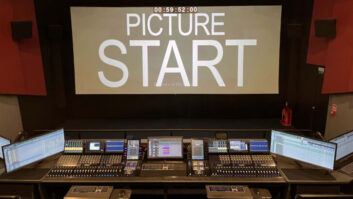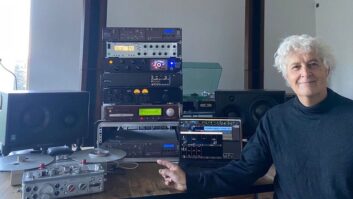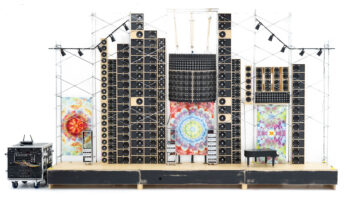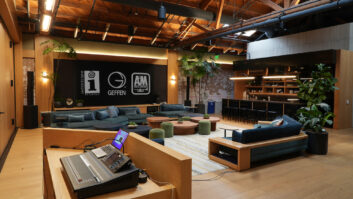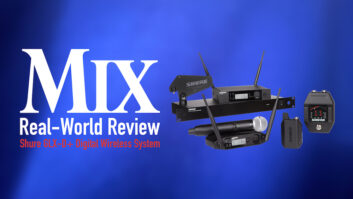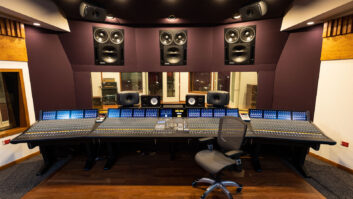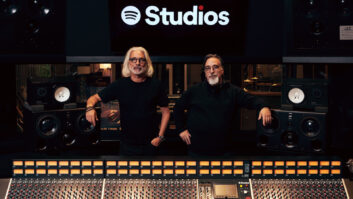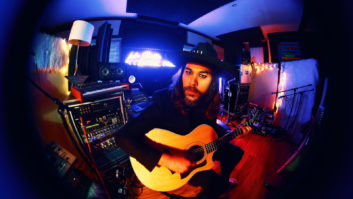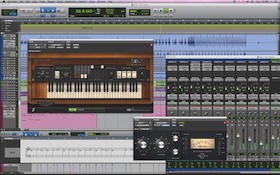
One of the best things about being an audio pro is shopping for gear. This is especially true in 2011 when the options are plentiful, prices are reasonable and the quality is high. We came up with the ultimate audio computer rig in two price categories: $10,000 and $25,000. We are taking for granted you already have a computer, so we’re just concentrating on the DAWs, plug-ins and hardware needed to get audio in and out of the box. Prices are mostly street value and offered with a range of options so you can build your own virtual dream rig to custom-fit your budget, workflow and must-have features. So get out your calculator and enjoy concocting your ultimate audio playstation.
$10,000 DREAM RIG
In this price category, although you have to be careful with your money, there are some solid options that bring pro features within the range of the tighter studio budget.
Avid Pro Tools is just one of the many DAWs on the market to satisfy the $10,000-budget rig.
There are a lot of freshly upgraded and affordable DAWs in the $10,000 price range including the new Cakewalk SONAR X1 Producer Edition ($399, reviewed here), Apple Logic Studio ($499), Steinberg’s Cubase 6 ($599) just released at NAMM, Avid Pro Tools 9 ($599) and EM 2011 Editor’s Choice–winning MOTU Digital Performer 7.2 ($795). All of the above sport a wide range of features found in more expensive DAWs while offering unique toolsets aimed at performers, composers, mixers and remixers. For instance, Logic Studio offers not only the Logic Pro 9 DAW, but also MainStage 2, Soundtrack Pro 3 and the Waveburner, Impulse Response and Compressor utilities, putting it high on the bang-for-the-buck list. MOTU’s Digital Performer won its EM accolades for solid performance, workflow upgrades, custom design features and its range of included instruments, plug-in processors, deft MIDI editing and film-scoring features. The field is broad here, and doing your homework may get you a DAW that fits your needs all-in-one rather than having to own a few to get the job done.
Plug-ins are always a consideration no matter your DAW of choice and it’s important not to clog up the resident computer’s DSP. For this reason, I’ve chosen some affordable OB plug-in accelerators. The FireWire-based Duende MINI ($1,799) studio pack from SSL includes a 16 to 32-channel upgrade, plus the Bus Compressor, Drumstrip, Vocalstrip, X-EQ and X-Comp plug-ins. The new UAD-2 Satellite DUO Flexi ($1,199) from Universal Audio, also a FireWire box, comes bundled with the LA-2A and 1176LN compressor/limiters, and the Pultec EQP-1A EQ plug-ins, plus a $500 voucher to buy more UAD plug-ins from a sizable list that should fit anyone’s processing needs. If you have the heart of a gambler, you could go with the discontinued but now-heavily discounted Waves APA 32 or APA 44 audio processing accelerator from Waves. I found an APA 32 for $99 at Guitar Center (formerly $800) that runs six IR-1 reverbs or nine linear-phase equalizers or 12 C4 multiband parametric processors at 44.1 kHz. The APA 44 is discounted to $1,350, boasting 30-percent more plug-in power than its little brother. Keep in mind, these boxes are no longer supported by Waves beyond Version 5.9 so you could never upgrade, but for $99, this is a bargain-hunter’s dream. I’m throwing another $1,000 into this basket for other plug-ins I could purchase from a range of companies like McDSP, Waves, SoundToys, Nugen Audio, Sonnox and more.

The FireWire-based Mackie Onyx 1640i was chosen for both its sonic capabilities and feature set.

The API 500-6B provides six slots and an internal power supply.
There are a lot of affordable preamp/converter options on the market, allowing me to get into my DAW cleanly and in style. To best optimize the remaining dollars, I think it’s important to have a rack of at least eight solid, affordable preamps, then purchase at least two channels of boutique signal path for vocals and other A-list overdubs that will sit high in the mix. For my front end, the win in the value category goes to the FireWire-based Mackie Onyx 1640i, both for its sonic capabilities and feature set. It offers 16 phantom-powered preamps, a full mixer with EQ, six sends, four stereo returns, talkback, grouping and more—all for $1,499. If you don’t need all that firepower, you could save some money and go with a simpler 8-channel FireWire preamp like the MOTU 8pre ($599), M-Audio ProFire 2626 ($699) or the Lightpipe-only PreSonus DigiMAX D8 ($399) or Focusrite OctoPre MKII ($499). For boutique I/O options, there’s no beating a 500 Series rack for versatility and future upgrades. It all starts with the empty rack to hold our modules. The API 500-6B ($425) gives me six slots and an internal power supply. Or, I could go with the Radial Engineering Workhorse 5000 ($1,399) that holds eight modules and includes an integrated summing mixer. As for modules, the world is my oyster: There are many companies making 500 Series–compatible units. They’re generally priced between $250 and $800, with some companies offering D.I.Y. bargains below that. Look at Five Fish Studios and DIY Audio and diyrecordingequipment.com for some great projects and options.
At $10k, it’s about the picking and choosing. But just because your dollars are limited, it doesn’t mean you can’t have a great-sounding rig. By starting with the choices above and doing some careful homework with your personal workflow in mind, you can find the best combination of gear within your budget to get the best sound possible.
$25,000 DREAM RIG
Thanks to the ever-expanding range of affordable audio products, creating the ultimate computer-based audio rig for $25,000 offers a range of choices that only the pickiest pro would scoff at.
For a DAW, I’ve chosen Pro Tools 9 HD Native ($3,495). This offers all of the features expected of a world-class workstation, plus the ability to operate with a range of I/Os from a number of manufacturers, offering unsanctioned, “back door” Pro Tools compatibility. Pro Tools 9 HD Native works exactly as a TDM system excluding TDM plug-ins and Pro Tools 9 TDM’s HEAT (Harmonically Enhanced Algorithm Technology). So I don’t miss out on any virtual flavor, I’ve opted to buy Crane Song’s Phoenix plug-in ($450) designed by Dave Hill, who was brought in by Avid to collaborate on the design of HEAT.

At the $25,000-budget level, the Universal Audio UAD-2 Satellite QUAD Omni Version 5.7 offers 50 UAD plug-ins running on the latest and fastest DSP chips.
Speaking of plug-ins, I’ve got plenty from which to choose, starting with the new UAD-2 Satellite QUAD Omni Version 5.7 ($4,499) from Universal Audio. The Omni bundle offers 50 UAD plug-ins running on four of the latest and fastest DSP chips, providing me with glitch-free processing that won’t tax the computer’s internal DSP. In addition, UAD-2 Satellite is FireWire-based, meaning it doesn’t eat up valuable PCIe slots reserved for my Pro Tools card and possible future system expansion. For processing inside the box, I’ve opted to buy the Waves Diamond Native bundle ($2,500) and the company’s Tony Maserati Collection ($375) to add some star-engineer personality to my virtual processor package. For more virtual emulation, I’ve chosen the Slate Digital (slatedigital.com) Virtual Console Collection (price TBA but I’m guessing for less than $500). It comprises two plug-ins, the Virtual Channel and Virtual Mixbuss, each allowing you to choose from one of six modeled consoles. This gives me the power to sculpt my tracks’ sonic signatures in a nearly endless number of ways. Rounding out my plug-in collection is SoundToys Native Effect Bundle ($495), which includes the Decapitator, PanMan, EchoBoy, FilterFreak and more. Lastly, I’m buying the McDSP Emerald Pack Native V. 5 ($1,495). This bundle offers the 6030 Ultimate Compressor, Analog Channel V. 5, Channel G V. 5 and much more.

For I/O selection, the Lynx Aurora 16 provides 16×16 analog and 16×16 AES/EBU.
I’m not neglecting the all-important I/O department; rather, I choose to go with a 16×16 system that leaves room for future expansion, should I need it. The most cost-effective for starters is the Lynx Aurora 16 ($2,995, plus $360 Pro Tools expansion card). The system offers 16×16 analog and 16×16 AES/EBU. Other more pricey options include Avid’s HD IO ($4,995), which has 16×16 analog I/O and two channels of AES/EBU I/O (supports 192kHz single-wire), two channels of S/PDIF I/O and eight channels of ADAT I/O (supports S/MUX II and IV). Next up the ladder in price is the Apogee Symphony Chassis ($1,695, plus $1,995 for 16 analog in, plus $1,995 for 16 analog out, plus the $530 X-HD card for Pro Tools—bringing the total for this option to $6,215). Still higher are similarly spec’d converters from Mytek for $7,785, leaving little money for necessary extras (which I’ll mention in the next paragraph), but the option is there should you want to go high end.

When thinking about analog summing, keep in mind the Dangerous Music 2-Bus.
Analog summing is the ultimate outside-the-box extra for discerning mixers, and I’ve got a range of products from which to choose. The Dangerous Music 2-Bus ($2,649) offers 16 inputs, stepped attenuator output control and is fully linkable with 2-Bus, 2- Bus LT and MixerDAW Studio for later expansion. The Neve 8816 ($3,695) analog-summing mixer includes 16 input channels offering level, pan, cut and cue controls, plus +15dB gain range accommodation for both -10dBV and +4dBm input levels. The SPL MixDream ($3,499) analog summing mixer offers adjustable insert level, stereo expansion control with infinite gradation, an adjustable analog peak limiter and adjustable outputs with added in/out switching of Lundahl transformers. For tube-lovers, there is the Tube-Tech SSA-2B ($4,275) stereo summing amplifier. The unit can handle 10 stereo channel inputs, with the first two stereo ins switchable to function as four mono inputs. The outputs are balanced with fully floating transformers, and there are 23-step gold-plated output gain controls for level matching.
By picking and choosing your personal favorites from these lists and balancing the budget across the other choices, you can put together a killer system for $25,000 that is upwardly expandable and able to handle a range of input and output needs for tracking, mixing and mastering.
